
Juncaceae is a family of flowering plants, commonly known as the rush family. It consists of 8 genera and about 464 known species of slow-growing, rhizomatous, herbaceous monocotyledonous plants that may superficially resemble grasses and sedges. They often grow on infertile soils in a wide range of moisture conditions. The best-known and largest genus is Juncus. Most of the Juncus species grow exclusively in wetland habitats. A few rushes, such as Juncus bufonius are annuals, but most are perennials.

The United States Range is one of the most northern mountain ranges in the world and of the Arctic Cordillera and is surpassed only by the Challenger Mountains to the northwest. The range is located on the northeastern region of Ellesmere Island in Nunavut, Canada and is part of the Innuitian Mountains. The highest mountain in the range is Mount Eugene. The British Empire Range is immediately to the west of the United States Range.

Juncus is a genus of monocotyledonous flowering plants, commonly known as rushes. It is the largest genus in the family Juncaceae, containing around 300 species.

Juncus effusus, with the common names common rush or soft rush, is a perennial herbaceous flowering plant species in the family Juncaceae. In North America, the common name soft rush also refers to Juncus interior.

Juncus bufonius, known commonly as toad rush, is a widespread flowering plant species complex in the rush family Juncaceae.

Juncus kraussii commonly known as salt marsh rush, sea rush, jointed rush, matting rush or dune slack rush, is of the monocot family Juncaceae and genus Juncus. It grows in salt marshes, estuarine and coastal areas.

Oreojuncus trifidus is a species of rush known by the common names highland rush and three-leaved rush. It is native to the Northern Hemisphere, where it is an arctic/montane species with an amphi-atlantic distribution.

Grandma Lake Wetlands State Natural Area is a Wisconsin Department of Natural Resources-designated State Natural Area featuring the undeveloped, pristine 44-acre Grandma Lake, which lies in a depression formed during the last glacial period. The lake is ringed by a large, open sphagnum bog mat. The bog mat is surrounded by a coniferous swamp of tamarack and black spruce. The bog mat supports a plant community that is considered diverse and unusual, with several rare species present, including: bog arrow-grass, dragon's mouth orchid, livid sedge, small-headed bog sedge, as well as one of only a few known populations of bog rush in the State of Wisconsin. In 1991, the US Forest Service designated the site as a Research Natural Area. Also, the site is listed as one of Wisconsin's Wetland Gems, by the Wisconsin Wetlands Association.

Black Tern Bog State Natural Area is a Wisconsin Department of Natural Resources-designated State Natural Area featuring 20 acres of quaking sphagnum bog surrounding two small seepage lakes situated in a pitted outwash plain. The bog is rich in plant species, such as sundews, pitcher plant, bogbean, and bog rosemary, as well as three species of bog orchids: swamp pink, grass pink, and rose pogonia. The state-endangered bog rush also grows here. Birds known to nest here include black tern, American bittern, killdeer, and mallards.

Juncus antarcticus is a flowering plant species in the rush family Juncaceae, native to both New Zealand and Australia.
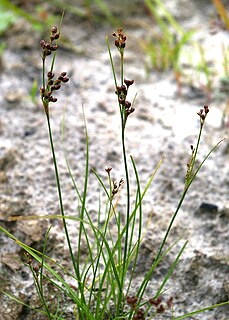
Juncus compressus is a species of Juncus.
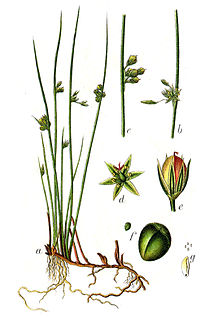
Juncus filiformis, called the thread rush, is a species of flowering plant in the genus Juncus, with a circumboreal distribution. It has been introduced to South Georgia Island. It is typically found in wetlands, on the borders of lakes and streams.
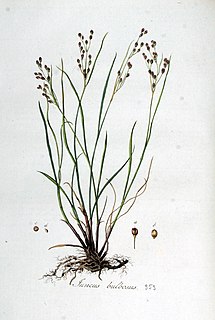
Juncus bulbosus, the bulbous rush, is a species of flowering plant in the genus Juncus, native to Iceland, the Faroes, Europe, Macaronesia, and northwest Africa. It has been introduced to Australia, New Zealand, and some locations in northern North America. It is capable of nuisance growth in lakes and streams.
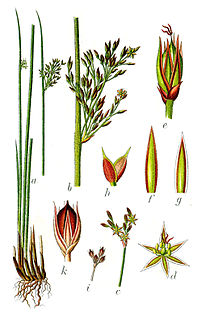
Juncus inflexus, the hard rush, is a species of flowering plant in the genus Juncus, native to Europe, Asia and Africa, and introduced in Sri Lanka, Java, Île Amsterdam and Île Saint-Paul, Victoria in Australia, New Zealand, Uruguay, and eastern North America. It is a glycophyte.
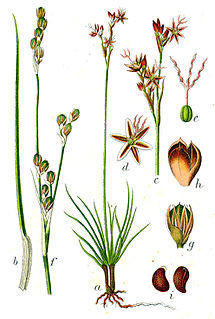
Juncus squarrosus, called goose corn, heath rush, and mosquito rush, is a species of flowering plant in the genus Juncus, native to Iceland, Europe, and Morocco, and introduced to Greenland, Svalbard, Tasmania, New Zealand, and the US state of Wisconsin. It is pollution-tolerant.

Juncus alpinoarticulatus, called the northern green rush and the alpine rush, is a species of flowering plant in the genus Juncus, with a circumboreal distribution. It prefers wet sandy soils, peat bogs, acidic fens, and ditches.
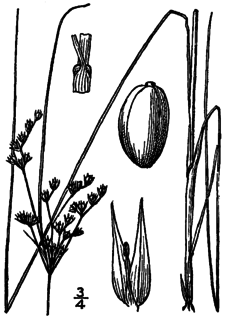
Juncus dudleyi is a widespread species of rush, native to North America, and introduced to northern South America, Japan, Great Britain and central Europe. Its chromosome number is 2n=80.
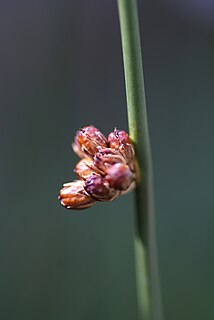
Juncus arcticus, called the arctic rush, is a species of flowering plant in the genus Juncus, native to the subarctic and subalpine northern hemisphere. It is typically found in wetland and riparian habitats.
Juncus biglumis, called the two-flowered rush, is a species of flowering plant in the genus Juncus, native to the subarctic and subalpine Northern Hemisphere. It has three divergent genetic lineages that may represent cryptic species.

Juncus triglumis, called the three-flowered rush, is a species of flowering plant in the genus Juncus, native to the subarctic and subalpine Northern Hemisphere. It is typically found in calcareous tundra habitats and arcto-alpine fens. It is often found in association with Carex atrofusca and Carex bicolor in the so-called Caricion bicolori-atrofuscae alliance.


















